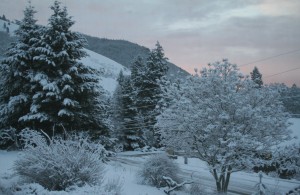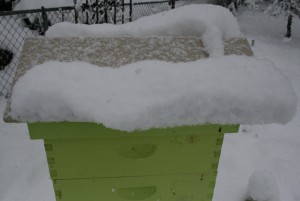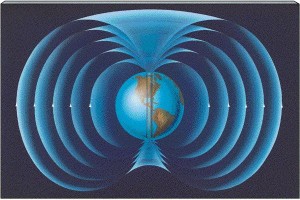 When I looked out the window this morning the snow-blanketed hills were back lit with the blush of the rising sun. I grabbed my camera to capture the moment and almost caught the full effect before it stole completely away. Then I remembered how impressed my students were in class by the bees keeping a constant brood-rearing temperature of 93 degrees inside the hive, and how the roof of our hive sheds snow seemingly faster than a vehicle warming in the driveway! Quick, quick I donned my muck boots (and shed any pretense of style)and ran out to the hive in my robe in order to illustrate to my class and you the power the bees have to keep themselves warm in the winter.
When I looked out the window this morning the snow-blanketed hills were back lit with the blush of the rising sun. I grabbed my camera to capture the moment and almost caught the full effect before it stole completely away. Then I remembered how impressed my students were in class by the bees keeping a constant brood-rearing temperature of 93 degrees inside the hive, and how the roof of our hive sheds snow seemingly faster than a vehicle warming in the driveway! Quick, quick I donned my muck boots (and shed any pretense of style)and ran out to the hive in my robe in order to illustrate to my class and you the power the bees have to keep themselves warm in the winter.
The hive was already losing it’s snow cap, and it was 30 degrees F out! What’s happening inside the hive in winter?
winter?
Winter Cluster
Think of the Earth herself with a hot, molten core ever-cooling until it reaches the earth’s crust, or mantle.  The same goes for the bees in winter. They gather together in a ball, called a cluster, with the queen in the center and keep each other warm. In the cluster’s core the temperature reaches 90 degrees F. The bees produce this heat by vibrating their wing muscles. You can put your ear against the hive and hear them quietly humming away in winter. I found an interesting scientific article showing infrared images of hives and the cluster within: http://www.beebehavior.com/infrared_camera_pictures.php See how much the cluster of bees looks like this cut-away of the earth? The article doesn’t mention anything about the bees’ circulation within the cluster, but I’ve read before that the warm bees from the center will rotate outward to the exterior, trading places with the cooler bees on the surface, or mantle. In my imagination this circulation is a microcosm of the earth’s electromagnetic field:
The same goes for the bees in winter. They gather together in a ball, called a cluster, with the queen in the center and keep each other warm. In the cluster’s core the temperature reaches 90 degrees F. The bees produce this heat by vibrating their wing muscles. You can put your ear against the hive and hear them quietly humming away in winter. I found an interesting scientific article showing infrared images of hives and the cluster within: http://www.beebehavior.com/infrared_camera_pictures.php See how much the cluster of bees looks like this cut-away of the earth? The article doesn’t mention anything about the bees’ circulation within the cluster, but I’ve read before that the warm bees from the center will rotate outward to the exterior, trading places with the cooler bees on the surface, or mantle. In my imagination this circulation is a microcosm of the earth’s electromagnetic field: 